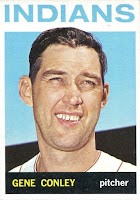Theodore Bernard Kluszewski
Cincinnati Redlegs
First Base
Born: September 10, 1924, Argo, IL
Signed: Signed by the Cincinnati Reds as an amateur free agent in 1946
Major League Teams: Cincinnati Reds 1947-1957; Pittsburgh Pirates 1958-1959; Chicago White Sox 1959-1960; Los Angeles Angels 1961
Died: March 29, 1988, Cincinnati, OH (age 63)
Ted "Big Klu" Kluszewski was a powerful slugger with the Reds throughout the 1950s, known as much for his huge biceps and his sleeveless jerseys as his home run totals. A four-time All-Star, Kluszewski enjoyed his best season in 1954, leading the National League in home runs (49) and RBIs (141), while striking out only 35 times. He finished second in the 1954 N.L. MVP voting behind Willie Mays (#130).
Kluszewski played 15 years in the Majors, tallying 279 home runs. His sole postseason appearance came in the 1959 World Series when he hit .391 and launched three home runs for the White Sox in a losing effort against the Dodgers. Following his playing days, Kluszewski served as a Reds coach during the Big Red Machine years between 1970 and 1978.
Building the Set
August 30, 1988 in Millville, NJ - Card #65
There were two baseball card stores located on High Street of my hometown Millville, NJ while I was growing up. The first was affectionately known as the "Card Doctor's" and I have no idea as to the official store name or any details on the store's owner. The second was Brokell's, located in a small stand-alone building. After a quick Google Maps search, I believe the former location of Brokell's is now a Tae Kwon Do studio? (I honestly don't know if this is right building or not, but it seems right.)
I'm also not sure what would have led to my Dad and me to head over to Brokell's on this late summer Tuesday. Dad worked over the summer, so the fact that this card was purchased on a Tuesday is even more mysterious to me. This was the only card we purchased that day and we weren't doing much to help pay Mr. Brokell's rent as my records show we paid only $2 for the card. This is one of four cards we acquired for the set from Brokell's, all purchased between April and October 1988.
The Card
As this is the first Reds card in the set, we need to talk about the use of the "Redlegs" name on all the Reds cards. The Reds adopted the Redlegs moniker in 1953 at the height of the nation's Red Scare for fear of being associated with the threat of Communism. Topps followed suit until the "Reds" name was restored for the 1959 baseball season. All Topps Reds baseball cards issued between 1954 and 1959 include Redlegs as the team name.
Kluszewski's portrait on this card is the same as his 1955 Topps card. The action shot shows him presumably crossing home plate after hitting a home run and shaking hands with #23, who I had thought was most likely his former teammate Jim Greengrass (#275). A review of his Home Run Log courtesy of Baseball Reference shows that Greengrass was never on base during one of Kluszewski's 251 home runs while with the Reds. However Stan Palys, who assumed #23 after Greengrass had been traded to the Phillies on April 30, 1955, was on base for three of Big Klu's home runs.
This action photo was most likely taken after one of three home runs in 1955 - June 24th off Murry Dickson (#211), July 1st off Bob Buhl (#244) or July 2nd again off Buhl - all of which occurred when Palys was on base.
1956 Season
1956 was to be Kluszewski's last great season, as he hit 35 home runs and knocked in 102 runs. He'd never again come close to those marks, as a bad back hampered him the rest of his career. According to his SABR biography, the bad back resulted from a 1956 clubhouse scuffle. Other sources quote Big Klu as saying the bad back was a result of a sudden movement to field a ball at first on opening day. His biography, Big Klu: The Baseball Life of Ted Kluszewski, seems to conclude once and for all that the clubhouse fight was nothing but a rumor. Both Kluszewskii and the alleged antagonist, infielder Chuck Harmon (#308), deny any fight ever occurred.
1957 was to be the slugger's final season with the Reds as he was traded to the Pirates on December 28, 1957 for first baseman Dee Fondy (#112).
|
|
|
|
First Mainstream Card: 1949 Leaf #38
First Topps Card: 1951 Topps Red Backs #39
Last Topps Card (as a player): 1961 Topps #65
First Topps Card (as a coach): 1973 Topps #296
Last Topps Card (as a coach): 1974 Topps #326
Most Recent Mainstream Card: 2015 Diamond Kings #128
Topps Flagship Set Appearances (13): 1951-1961, 1973-1974
234 - Kluszewski non-parallel baseball cards in the Beckett online database as of 10/12/16
Sources:
Baseball Reference
Beckett Database
Big Klu: The Baseball Life of Ted Kluszewski - pages 75 and 76
SABR
The Trading Card Database
In some cases, the first and last cards listed above are subjective and chosen by me if multiple cards were released within the same year. Most recent mainstream card may also be subjective and does not include extremely low serial numbered cards, buybacks or cut autograph cards.
Previous Card / Next Card
Order Collected: #97 Jerry Lynch - Pittsburgh Pirates / #43 Ray Moore - Baltimore Orioles




















































